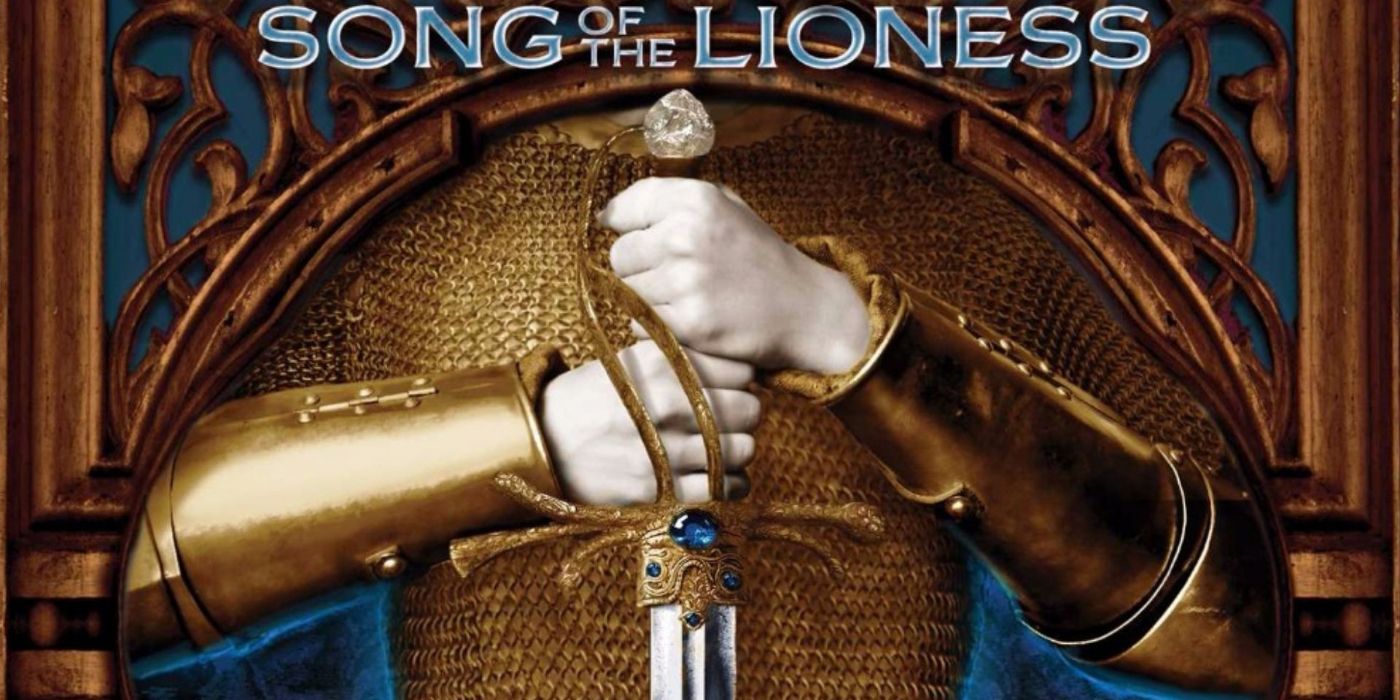After ‘The Hunger Games,’ Please Adapt This YA Fantasy Classic
The Big Picture
- Film studios continue to adapt young adult literature for the screen, with upcoming projects like Percy Jackson and the Olympians and A Court of Thorns and Roses.
- Tamora Pierce’s groundbreaking The Song of the Lioness YA book series paved the way for today’s fantasy stories with its multidimensional heroine and progressive themes.
- Alanna, the series’ protagonist, created common genre tropes and defies gender expectations, making her a legendary character who deserves a big-budget adaptation.
Film studios extracting movie ideas from young adult literature might have peaked after the phenomenal success of the Twilight and The Hunger Games franchises, but YA adaptations are far from nonexistent. The Hunger Games: The Ballad of Songbirds & Snakes debuted to an excellent reception. Disney+ premieres Percy Jackson and the Olympians on December 20. Numerous projects are in the pipeline based on bestselling titles like Legend, Raybearer, and Red Queen. And, of course, there’s A Court of Thorns and Roses, helmed by the prestige of Outlander producer Ronald D. Moore. Because “young adult” is a category and not a genre, its vast catalog of themes, styles, and settings stretches across decades with virtually no limit for potential screen adaptations. But one seminal series remains so synonymous with modern sensibilities, it’s flabbergasting that it took until 2019 for Lionsgate and Playground Entertainment to option the series — with the lack of project updates since the announcement equally surprising.
Between 1983 and 1988, groundbreaking female novelist Tamora Pierce published The Song of the Lioness quartet. It wasn’t enough that these books laid the foundation for the next four decades; they also paved the way for today’s literary giants to flourish. For countless readers, including Leigh Bardugo and Sarah J. Maas, Tamora Pierce’s works were the linchpin of linchpins. They defined tropes that weren’t tropes yet, and they struck a formative match deeper than beloved archetypes: a passion for stories about multidimensional heroines. Although The Song of the Lioness sits comfortably within the conservative YA guidelines of the ’80s, its origins as a 700-page adult novel and its surprisingly progressive ideations result in a superbly gritty middle ground: a fantasy tale mature enough for older viewers without excluding the teenagers hungry for quality storytelling and thoughtful representation. With its tempestuous heroine who defies the gender binary, a tenderly perceptive coming-of-age focus, a sophisticated love triangle, and a medieval land filled to the brim with magic, political scheming, royal court shenanigans, and gods, The Song of the Lioness is screaming for an adaptation.

The Hunger Games
Katniss Everdeen voluntarily takes her younger sister’s place in the Hunger Games: a televised competition in which two teenagers from each of the twelve Districts of Panem are chosen at random to fight to the death.
- Created by
- Suzanne Collins
- First Film
- The Hunger Games
- Upcoming Films
- The Hunger Games: The Ballad of Songbirds and Snakes
What Are ‘The Song of the Lioness’ Books About?
Tamora Pierce, a devoted fan of J. R. R. Tolkien‘s The Lord of the Rings, wrote The Song of the Lioness in part because her favorite genre stories had such a dearth of heroines. In Pierce’s words, “I tried to write the kind of thing I was reading, with one difference: the books I loved were missing teenaged girl warriors. I couldn’t understand this lapse of attention on the part of the writers I loved, so until I could talk them into correcting this small problem, I wrote about those girls, the fearless, bold, athletic creatures that I was not, but wanted so badly to be.”
Fast-forward several decades, and a single publisher listing for Pierce’s cumulative works reveals her unrivaled influence. A Court of Thorns and Roses writer Sarah J. Maas raves, “Tamora Pierce’s books shaped me not only as a young writer but also as a young woman. She is a pillar, an icon, and an inspiration.” Leigh Bardugo of Shadow and Bone and Ninth House said, “Tamora Pierce didn’t just blaze a trail. Her heroines cut a swath through the fantasy world with wit, strength, and savvy. Her stories still lead the vanguard today. Pierce is the real lioness, and we’re all just running to keep pace.”
If such praise gives The Song of the Lioness a formidable legacy, Pierce makes living up to it look easy. The prolific writer’s debut follows Alanna of Trebond, a violet-eyed, red-haired, and fierce-tempered 10-year-old who longs to become a knight. Unfortunately, the medieval land of Tortall is also medieval in its sexism; knighthood is forbidden to women. Alanna’s emotionally absent father arranges for her to attend a convent. Stubbornly tenacious to a fault, Alanna disguises herself as a boy and switches places with her twin brother Thom, who has zero interest in traditional masculinity (and is a terrible swordfighter to boot). Freed from oppressive restrictions, Thom pursues his dream of becoming a mage while Alanna fulfills her knightly goal. Her heroic valor and her shattering of Tortall’s glass ceiling make her a legend, but not before an insightful journey into the quagmire that is adolescence.
‘The Song of the Lioness’ Created the Modern Fantasy Heroine
For fans of The Hunger Games‘ Katniss Everdeen, Alina Starkov of Shadow and Bone, and even Game of Thrones‘ Arya Stark and Ciri from The Witcher, Alanna of Trebond is the template. Our protagonist is a feisty, hotheaded girl with House Targaryen-violet eyes and a temper to match her flaming red hair. The land’s most powerful goddess blesses her, and her beloved celestial cat Faithful lives up to his name. Alanna’s chief characteristic hallmarks include masculine-coded traits: courageous, prideful, immature, a loner, and foul-mouthed. Given the choice to punch someone or intellectually debate them, she picks the former. Yet Alanna’s devoted, resilient, and caring, capable of forging a few strong friendships instead of a wider-cast, female-coded empathy. She habitually defies and redefines gender expectations, becoming the realm’s first woman knight in over a century.
In essence, Alanna takes Eowyn’s “I am no man” moment to its apex. By combating injustice and saving the kingdom, she disproves the notion of gender inequality. Women can be warriors. What’s more, binaries cannot hold her. Bigoted minds don’t alter overnight, but future generations of girls benefit from Alanna’s actions. Part and parcel of her Hero’s Journey is Alanna conquering her three great fears, embarking on quests, witnessing war at a vulnerable age, and discovering that her value isn’t predicated upon public opinion but self-worth. As Tamora Pierce’s website describes, “This story, all four books, is about the making of a hero. It’s also about a very stubborn girl.”
Published in 1983, The Song of the Lioness deals with gender in antiquated binary terms. Nevertheless, its intent remains remarkably progressive. Despite not using the language in-universe, Tamora Pierce confirmed Alanna as gender-fluid. As such, The Song of the Lioness is refreshingly frank about the ways Alanna’s body affects her sense of identity and her still-crystalizing self-worth. Her peers bully her because of her smaller frame and underdeveloped muscles. When Alanna enters puberty, she’s terrified; no one educated her about menstrual cycles. (But she has easy access to contraception! If only that were true of our world.)
Ultimately, Alanna finds contentment by combining the feminine and masculine concepts she values into a coherent whole. Her initial disdain for feminine-coded attributes evolves into appreciation when she understands she can reclaim them as radical strengths. She didn’t hate women; she chafed at Tortall’s society restricting individuals who are assigned genders at birth. She’s both warrior and healer, knight and mage, “sir” and “lady knight,” woman and man as she chooses.
‘The Song of the Lioness’ Would Make a Perfect Onscreen Series
Decades before the teen love triangle became nigh-compulsory for YA, The Song of the Lioness features an ahead-of-its-time depiction of a young woman discovering a fulfilling life partner as well as her sexuality. Alanna’s swoon-worthy first love is a Mulan-esque romance with Jonathan, the prince of Tortall. Initially knowing her as Alan, Jon keeps her secret, makes her his personal squire, and they fall in love. Then, Tamora Pierce introduces a revolutionary concept: first love doesn’t equal soulmates. Alanna rejects Jon’s proposal because being queen would limit her freedom. The couple part amicably (much to some fans’ dismay). Alanna takes several lovers throughout the series before marrying her endgame, George Cooper, a street-smart rogue and Tortall’s King of the Thieves. It’s a remarkably sensible love triangle that resists prioritizing male rivalry over the heroine’s character growth. When the individual love affairs overlap, Jon and George don’t even quarrel.
After The Song of the Lioness was published, Pierce continued to grow Tortall into a fantasy setting with centuries’ worth of lore. Her sprawling universe, a classic swords and horses high fantasy, contains numerous individual series and focuses solely on women’s stories. Arguably, a film studio could adapt any of these series. In fairness to her forging the genre’s rule-breaking commonalities, however, everything should start with Alanna. Audiences have proven time and again they would adore the series on every front: the royal politics, the evil relatives attempting coups, the personalized magic system, and the flawed, multidimensional, truly empowered heroine. Despite her self-admittedly hit-and-miss attempts at inclusivity, there’s no lip service in Pierce’s Tortall. In an interview with Leigh Bardugo via Parnassus Books in 2017, the author said, “[Including diverse characters is] part of my lifelong desire to make fantasy as realistic as possible: I want readers to feel they can enter the stories and take part.” Although imperfect, this is Pierce’s legacy. When I was a little girl reading Alanna’s arc, it lit a world-shifting conflagration in me, the longevity of which I never imagined. It’s easy enough to update The Song of the Lioness‘ era-related flaws to suit current nuances. The Hunger Games still lives on, so why not celebrate the series that defined young adult literature as we know it?
The Hunger Games is available to stream on Hulu. The Hunger Games: The Ballad of Songbirds & Snakes is in theaters now.
Watch on Hulu
#Hunger #Games #Adapt #Fantasy #Classic

